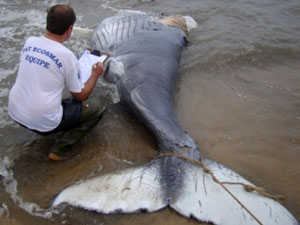TOP STORIES
Herpes Kills Inwood Owl An owl found dead in Inwood Hill Park last month was killed by the herpes virus, a Department of Environmental Conservation spokesman said Tuesday. Necropsy results for the female great-horned owl concluded the virus had attacked the birds spleen, liver and alimentary canal.
An owl found dead in Inwood Hill Park last month was killed by the herpes virus, a Department of Environmental Conservation spokesman said Tuesday. Necropsy results for the female great-horned owl concluded the virus had attacked the birds spleen, liver and alimentary canal.
Avian herpes is a common disease similar to chicken or smallpox, and is contagious from bird to bird. It cannot be transmitted from birds to humans.
The city's Urban Park Rangers and DEC officials said the nearly 4-pound bird, whose wingspan was approximately 3 feet, was in good condition otherwise and had died just before being found. Park Rangers removed the animal, which was the size of a large turkey, after it was discovered near the caves in the last natural forest in Manhattan.
26 Jul 2011
C Zanoni
Location: Manhattan, New York, USA - Map It

>>> FULL ARTICLE
[Baby humpback whale found dead on beaches in Southern Bahia]
(Translation Disclaimer)
 A baby humpback whale was found dead on a beach on the north shore of Santa Cruz de Cabral in the south of Bahia, on the evening of Monday (25), according to the Institute Ecosmar Pat. The whale was stranded on the beach, located in the district of St. Andrew, until the morning of Tuesday (26) and was dropped by Pat Ecosmar and the Humpback Whale Institute.
A baby humpback whale was found dead on a beach on the north shore of Santa Cruz de Cabral in the south of Bahia, on the evening of Monday (25), according to the Institute Ecosmar Pat. The whale was stranded on the beach, located in the district of St. Andrew, until the morning of Tuesday (26) and was dropped by Pat Ecosmar and the Humpback Whale Institute.The baby was two months and four meters long. According to Paolo Botticelli, coordinator of field teams Ecosmar Pat, the animal was still part of the umbilical cord and was probably one of the first born in the southern region of Bahia in the 2011 season.
There were no injuries to the whale, which had collected tissues and organs in an attempt to identify the causes of death of the mammal.
Can Amphibian Fungal Disease Be Beaten?
Over the past 30 years, around 200 species of amphibians have disappeared due to chytridiomycosis, a fungal infection. The scientific community has attempted to fight the pathogen, without success. Now, an international research group has reviewed every technique in order to prevent the effects of this disease and local extinctions.
"There are several alternatives for mitigating chytridiomycosis that are more effective than trying to prevent the pathogen from arriving or eradicating it from the environment," Jaime Bosch, a researcher at the National Natural Sciences Museum (MNCN-CSIC) in Spain and co-author of the new study on controlling the infection that has attacked 200 species of frogs, toads and other amphibians, said.
After reviewing all the current mitigation actions -- or those that could possibly be developed in the near future -- the researchers have concluded that new strategies based on the use of different methods to control infection levels "could be enough to prevent outbreaks of the disease and could, therefore, largely prevent local extinctions," says Bosch.
The study, which has been published in Frontiers in Zoology, has shown how the fungal amphibian pathogen (Batrachochytrium dendrobatidis) has been dispersed by human action. "It is a phenomenon that is practically unstoppable in our globalised world," the biologist explains.
27 Jul 2011
Cited Journal Article
D C Woodhams, et al. Mitigating amphibian disease: strategies to maintain wild populations and control chytridiomycosis. Frontiers in Zoology, 2011; 8 (1): 8 DOI: 10.1186/1742-9994-8-8.
>>> FULL ARTICLE
Researchers Concerned After Bat Disease Spreads To NC
Researchers are concerned because a new disease that has already killed hundreds of thousands of bats is now being found in North Carolina. Eyewitness News reporter Dave Faherty spent the night with a crew of bat biologists to find out how they're working to stop the spread of the disease.
Officials said bats are especially important during the summer months. "(Brown bats) can eat up to two tons of insects over the course of a summer, so bats consume a lot of insects," said Corinne Diggins with the North Carolina Wildlife Resources Commission. "A little brown bat can eat its weight in insects in one night." But White Nose Syndrome, a disease that only affects bats, is killing them by the hundreds of thousands across the eastern U.S.
It was first discovered in a cave in New York in 2006. In five years, it spread to 16 states and Canada. This year, it reached caves in four counties in North Carolina where biologists discovered dead bats.
OTHER WILDLIFE HEALTH-RELATED NEWS
 Trying to reduce ship-whale collisions in Santa Barbara Channel
Trying to reduce ship-whale collisions in Santa Barbara Channel- Identical virus, host populations coexist for centuries
- Architecture for the Birds
- Kansas drought also affects wildlife
- Drought Threatens Fish, Wildlife, Parks in Texas
West Nile Virus
- Chicken in Evergreen tests positive for West Nile Virus
(Evergreen, Alabama, USA - Map It )
) - State's first West Nile virus case of the year reported in Santa Barbara County
(Santa Barbara County, California, USA - Map It )
)
Huh?! That's Interesting!




